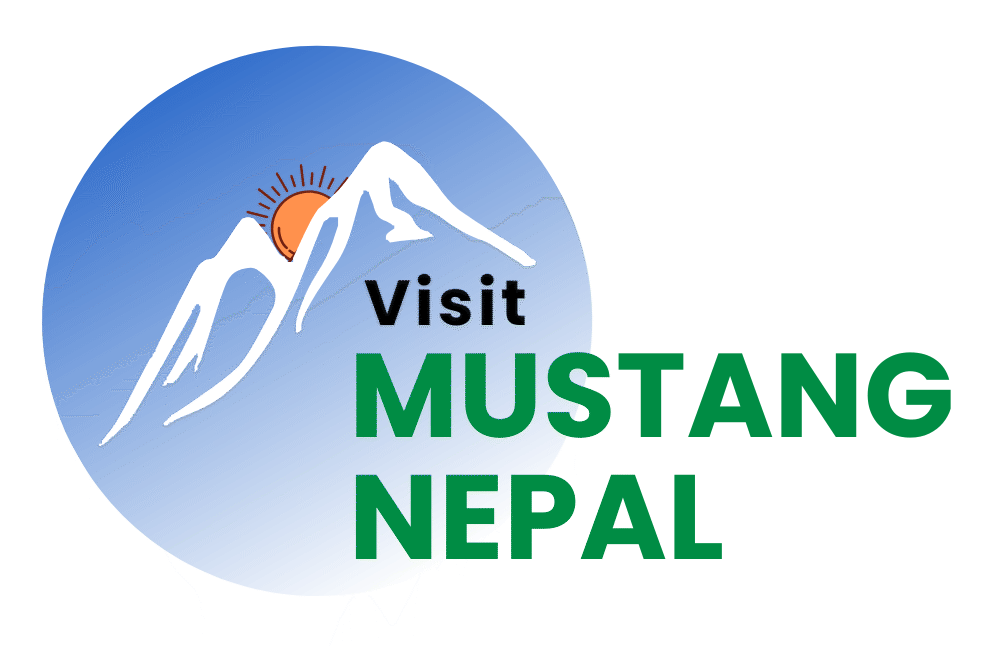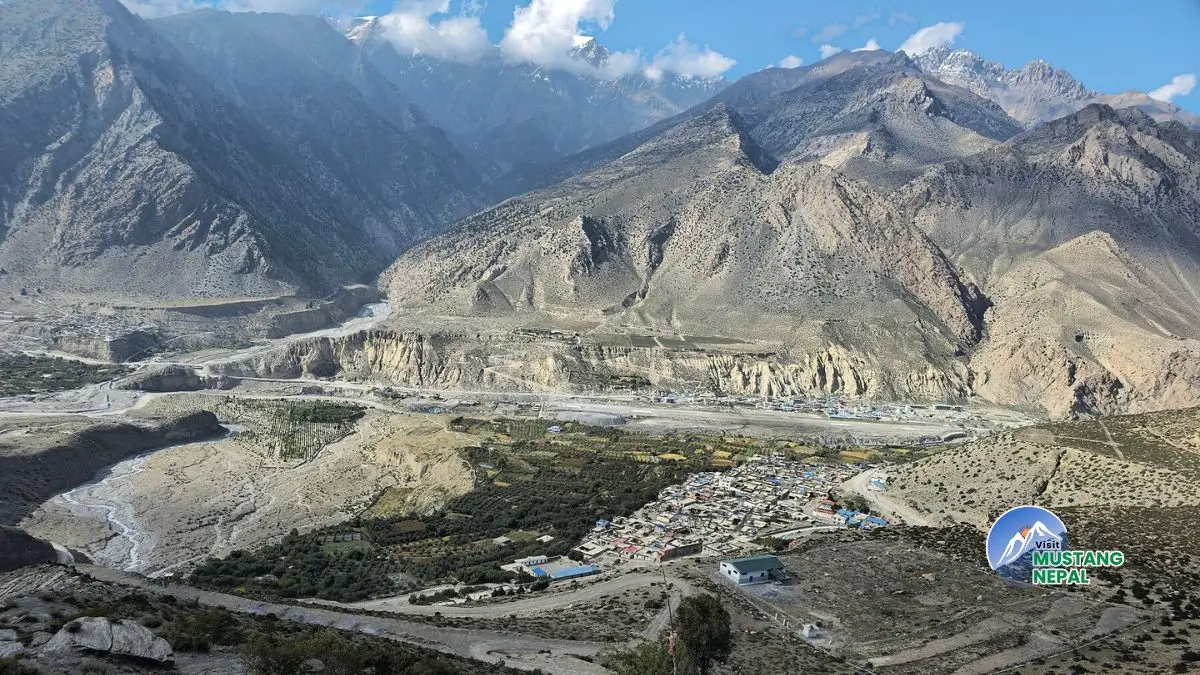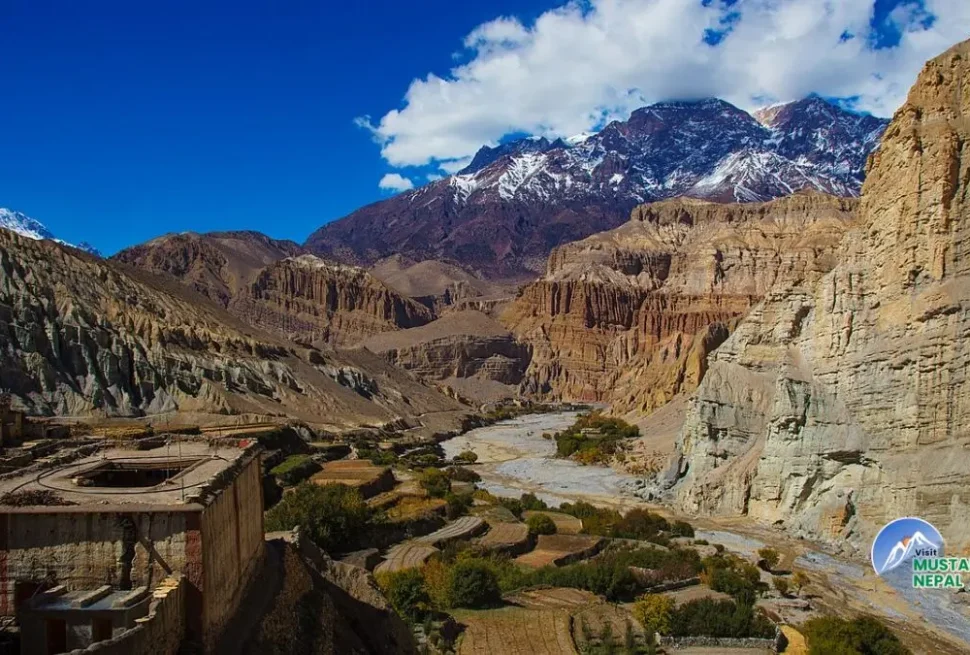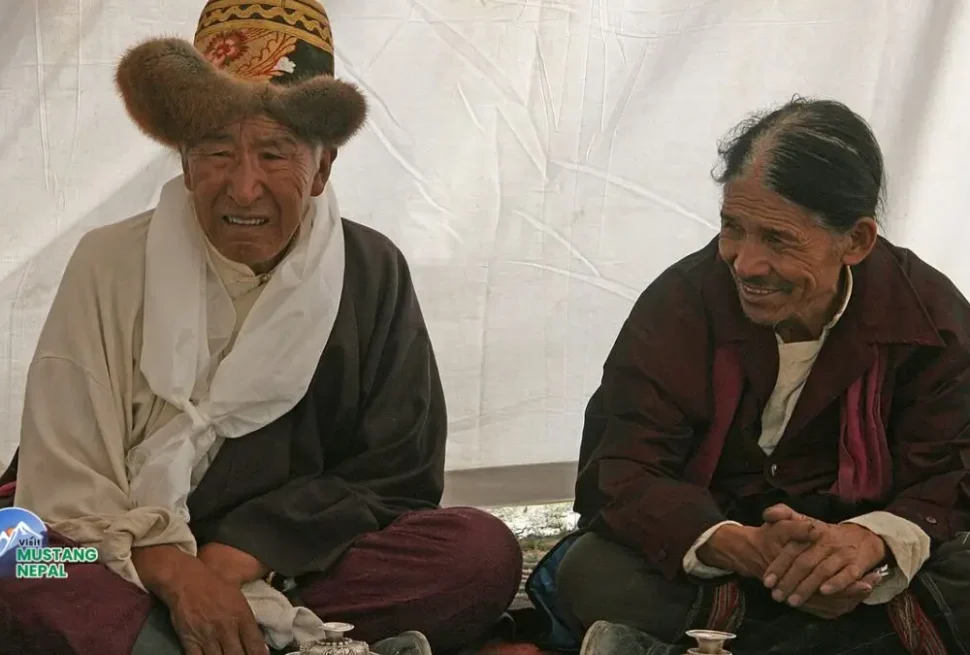Mustang is a living museum of culture and history. Once called the “Forbidden Kingdom,” Mustang was off-limits to outsiders for centuries, which is why its traditions remain so beautifully intact today. The history of Mustang is reflected in its dramatic terrain, ancient caves, and rich cultural legacy that continues to fascinate travelers from around the world.
The spectacular Annapurna and Dhaulagiri mountains surround it. It is home to the walled city of Lo Manthang as well as old monasteries with Tibetan Buddhist influences.
Mustang was once an independent kingdom ruled by the Loba (Lo) kings. It was an important trading center between Tibet and Nepal, where merchants bought and sold goods like salt and wool along the Kali Gandaki River. Being cut off from the outside world helped Mustang keep its special culture and traditions safe for hundreds of years, even when politics changed around them.
Because Mustang stayed isolated for a long time, it kept its culture. Mustang is only accessible with specific permits and has preserved its own culture, making it one of Nepal’s most fascinating places.
Planning a trip to Mustang? Our guided tours take you through Lo Manthang. Contact us today to start your journey.
Dates of Mustang History
| Date/Period | Event | Description |
| 1380 AD | Founding of Lo/Lo Manthang | King Ame Pal establishes the Kingdom of Lo and builds the fortified capital of Lo Manthang with its distinctive mud-brick walls that still stand today. |
| 1440 | Royal Palace Construction | The magnificent four-story royal palace is completed in Lo Manthang, serving as the seat of power and symbol of the kingdom’s authority for over 500 years. |
| Late 18th Century | Loss of Independence | After the Gorkhali conquest of Jumla in 1789, Mustang gradually lost its independence and was absorbed as a dependent tributary state within the expanding Kingdom of Nepal. |
| 1950s | Chinese Invasion of Tibet | China invades Tibet, leading to a refugee influx and setting the stage for resistance activities in Mustang. |
| 1960s | Establishment of Khampa Base | Thousands of Khampa fighters, led by commanders like Wangdu and supported by CIA covert operations, set up training camps and supply depots around Mustang. Lo Manthang becomes a strategic center for planning cross-border raids. |
| 1960-1974 | Active Resistance Operations | Khampa guerrillas conduct numerous raids into Tibet, attacking Chinese military convoys and installations. Fighters receive weapons, training, and funding from the CIA as part of Cold War strategies. |
| 1974 | Disarmament and End of Resistance | Under pressure from China and changing U.S.-China relations, Nepal’s government forces are disarming Khampa fighters. Many relocated to refugee settlements or integrated into local communities. |
| 1992 | Opening to Foreign Tourism | The Nepalese government allows limited tourism to Upper Mustang for the first time, requiring special permits and restricting visitor numbers to protect cultural heritage. |
| 2008 | End of Monarchy | The last king of Mustang, Jigme Dorje Palbar Bista (25th descendant of Ame Pal), loses official royal status when Nepal abolishes its monarchy, though continues as respected cultural leader until death in 2016. |
| 2008 | UNESCO Recognition | Lo Manthang is inscribed on UNESCO’s Tentative List as the “Medieval Earthen Walled City of Lo Manthang,” recognizing its outstanding universal value as a preserved medieval fortified city. |
| 2015 | Earthquake Impact | Major earthquakes damage historic monasteries and old buildings in Mustang, which leads to continuous restoration processes by local populations and foreign agencies. |
The Khampa Period Impact:
The Khampa resistance period (1960s-1970s) significantly impacted Mustang’s identity. It reinforces its Tibetan cultural connections and creates lasting ties between local communities and Tibetan refugees that continue today. This period represents an important chapter often overlooked in Mustang’s modern history, when the remote kingdom became an international battleground in the broader Cold War struggle.
Mustang Kingdom History (1380–Present)
In the 14th century, King Ame Pal united the region’s dispersed tribes and established the Kingdom of Lo. It is now known as Mustang. He established the walled city of Lo Manthang, which is now a proud representation of the kingdom’s might and past.
The walled city of Lo Manthang was not only founded in 1380, but its royal palace was built around 1440 AD, which still dominates the city today. This palace remains a symbol of Mustang’s medieval authority and resilience. The kingdom developed steadily and tightly under Ame Pal’s leadership, greatly influenced by Buddhist and Tibetan culture. Lo developed into a thriving commercial hub in addition to a political stronghold. In addition to preserving a rich cultural heritage that endures in the area to this day, this foundation assisted Mustang in maintaining its independence for generations.
The ancient walls, royal palace and monasteries of Lo Manthang are still in place even after over 500 years. The buildings are not mere monuments but they are in use by the royal family, monks and local people who continue to preserve their original purpose as they were many centuries ago.
Learn more about the history of Mustang.
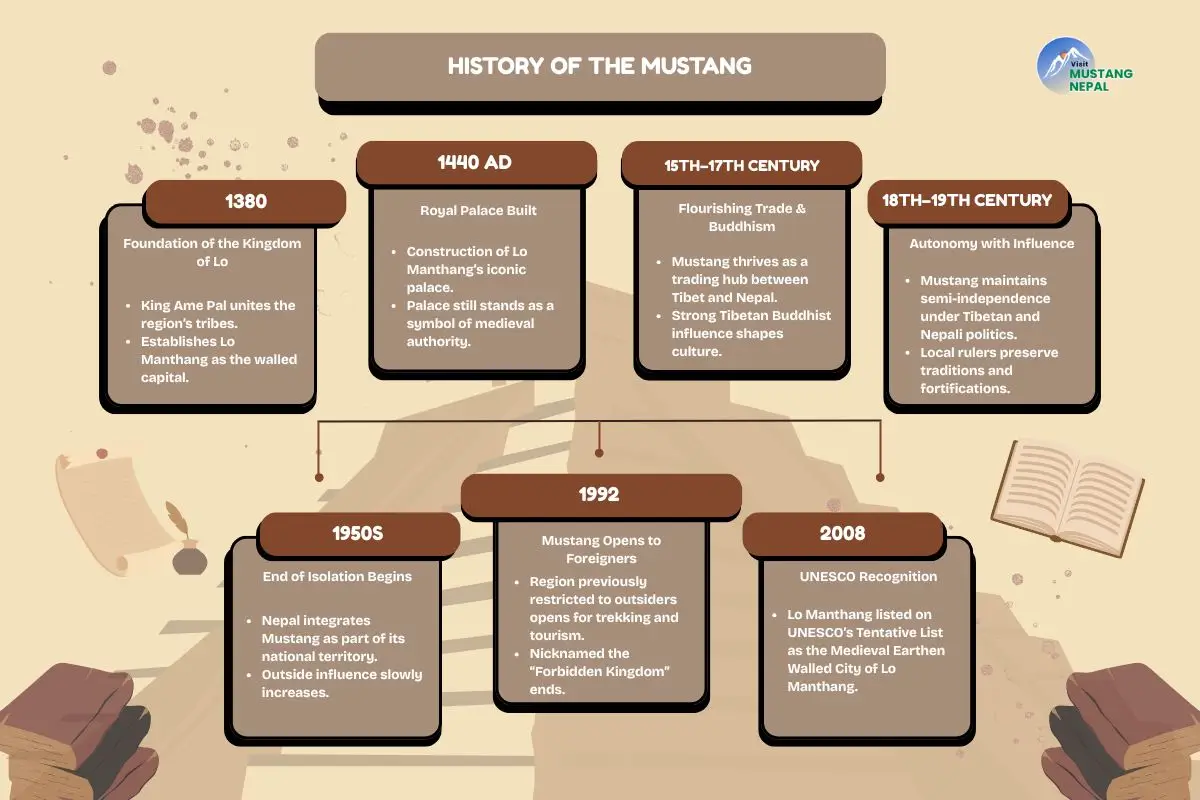
Ame Pal and the Founding of Lo Manthang (1380)
The Kingdom of Lo was established in the 1300s by Ame Pal, a Tibetan warrior and leader. In 1380, he built Lo Manthang as his capital city and surrounded it with high mud-brick walls that are still standing today. Ame Pal’s rule brought peace, strong leadership, and helped create Mustang’s unique identity.
Important events in Lo Manthang’s early history:
- 1380: Ame Pal builds Lo Manthang as a protected capital city.
- Late 1300s to 1400s: The city walls were expanded and major monasteries and Buddhist temples were built.
- Trade routes grow: Lo Manthang became an important stop on the salt trade road between Tibet and Nepal, making the kingdom wealthy and bringing different cultures together.
The Royal Palace (c. 1440) and Monastic Growth
In the mid-1400s, King Ama Pal built a grand four-story royal palace in Lo Manthang around 1440. This beautiful palace was more than just a home for the king – it became the heart of his kingdom, surrounded by protective walls that made Lo Manthang one of the world’s best-preserved medieval walled cities. During this same time, Buddhist monasteries flourished throughout Mustang. Subsequent kings built new important monasteries, such as Jampa, and also upgraded and improved older ones, such as the Namgyal Monastery. These monasteries became centers of learning, culture, and spiritual life, showing how much the royal family supported them. Buddhism helped make Mustang an important religious center in the Himalayas. These massive building projects showed that Mustang was wealthy from its position on profitable trade routes. The palace and monasteries created lasting symbols of royal power and religious faith that still shape Mustang’s culture today, more than 500 years later.
Mustang’s Role on the Kali Gandaki Trade Route
Mustang acted as a bridge connecting Tibet and Nepal. Grain, wool, textiles, and spices traveled northward through Mustang, while salt, a highly prized product, moved southward from the Tibetan plateau. This constant flow brought prosperity to Lo Manthang and the surrounding villages. Later, it became a bustling commercial center along the historic salt route because of its location.
The native way of life was enhanced by the ideas, languages, and practices that pilgrims, traders, and tourists shared while passing through Mustang. Strong cultural linkages were established through trade between the Tibetan and Nepalese groups. Trade has been a vital component of Mustang’s development and survival for generations since the kingdom’s control over this crucial route allowed it to preserve social stability and political sovereignty.
Travel Tip: Visit Lo Manthang to walk through the same fortress walls built by King Ame Pal in 1380, still standing tall after 600 years!
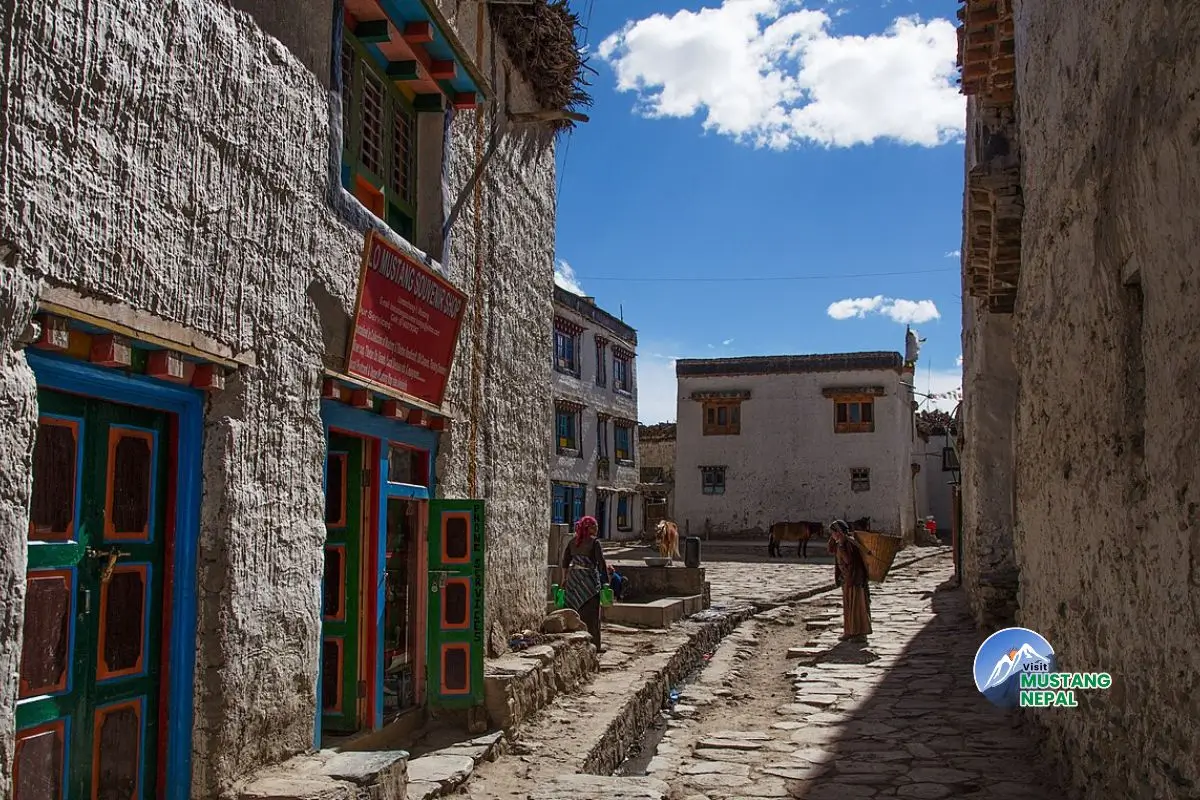
Why was Mustang called the Forbidden Kingdom?
Mustang is called the “Forbidden Kingdom” because it was closed to outsiders for hundreds of years. Hidden in the Himalayas, this remote area was cut off from Nepal and the world, which helped preserve its unique Tibetan culture, language, and traditions. The kings of Lo Manthang strictly controlled who could enter, allowing only some traders and religious pilgrims to pass through.
The name “forbidden” became more famous after China took over Tibet in the 1950s. Because Mustang sits on the border with Tibet, the Nepalese government worried about security and banned foreign visitors to protect the area’s culture and keep peace. Only in the early 1990s did Nepal allow small groups of tourists to visit Mustang. This careful control of visitors has helped keep the region’s ancient history and traditions alive, making Mustang a fascinating place that still attracts travelers today.
Upper Mustang History
Upper Mustang is called the “Last Forbidden Kingdom” and has over 1,000 years of history. It was once an important trade route between Tibet and Nepal, so Tibetan culture and Buddhism became a big part of local life. Kings ruled the area starting in the 1400s, and in 1441, King Ame Pal created the Kingdom of Lo and built the Lo Manthang Palace.
The Upper Mustang remained isolated from the outside world, and this isolation contributed to preserving the unique culture and traditions of this place for hundreds of years. Foreign visitors couldn’t enter until 1992, when Nepal’s government opened it to small groups of tourists. Visitors can now see the beautiful mountains, old monasteries, and traditional villages, but they still need special permits to protect the area’s culture. Today, Upper Mustang shows how its people have stayed strong and kept their history alive while adapting to the modern world.
Reserve Your Upper Mustang Trek Today! Discover ancient monasteries, traditional villages, and breathtaking mountains with our fully guided package
How did terrain affect the autonomy and trade of Mustang?
Mustang’s remote and rugged terrain helped protect it from many outside attacks and invasions. The deep valleys and high mountains created natural barriers that made it hard for enemies to enter. At the same time, Mustang controlled important trade routes that passed through its land, especially along the Kali Gandaki River.
This location allowed Mustang to become a key link between Tibet and Nepal for trading goods like salt and wool. Because of this control over trade, Mustang was able to stay independent and keep its unique culture alive, even while larger empires and kingdoms changed around it. The land’s natural defenses and trade opportunities helped Mustang balance isolation with connection.
Major Turning Points in Mustang’s History
Mustang’s history is marked by several significant turning points that have shaped its cultural, political, and social landscape.
Late-18th-Century Incorporation into Nepal (post-1789)
In the late 1700s, around 1789, Mustang became part of Nepal when the Gorkha armies expanded under King Prithvi Narayan Shah. This was a big change for Mustang – it went from being its own independent kingdom to becoming part of the larger country of Nepal. Nepal wanted to control Mustang because it was an important trade route between Tibet and India.
Even though Mustang lost its independence, the people kept their own culture and continued practicing Tibetan Buddhism. Being part of Nepal meant the local rulers had to work more closely with the Nepalese government, which changed how they governed and traded with other places.
The Khampa Years (1960s–70s)
In the 1960s and 1970s, Mustang became the center of the Khampa Resistance. The Khampa people were Tibetan fighters who opposed Chinese control of Tibet. After China invaded Tibet in 1950, many Khampas escaped to Upper Mustang, where they found safety and continued fighting for Tibetan freedom. Mustang became their secret base, where they planned attacks against Chinese soldiers.
The American CIA and other countries helped them by providing training and weapons. But by the late 1970s, the resistance weakened because China sent more troops, and politics changed. This period strongly shaped Mustang’s identity, making its connections to Tibetan culture and the fight for independence even stronger.
Opening to Foreign Visitors (1992) and Permit System
In 1992, Nepal’s government made an important decision to let tourists visit Upper Mustang for the first time. This was a big change that brought new money to the area and let outsiders see Mustang’s special culture. A small number of foreign visitors could now see the ancient monasteries, traditional villages, and beautiful mountains. But to keep Mustang’s culture safe and control tourism, the government created a special permit system. Travelers now had to get expensive permits to enter Upper Mustang. This system limited how many tourists could visit and made sure local people earned money from tourism while protecting their traditions and environment.
Earthquake Impacts & Restorations (1999–2015–ongoing)
The big earthquakes that hit Nepal in 2015 badly damaged Mustang, especially its old buildings and roads. Many ancient monasteries, traditional houses, and important cultural sites were hurt, putting Mustang’s history in danger. After the earthquakes, people started working to fix and rebuild these special places, trying to keep the unique building styles and cultural treasures that make Mustang special. Local people worked together with Nepalese and foreign organizations on these repair projects because everyone knew how important it was to save Mustang’s culture. As of 2023, this work is still going on, showing how strong the people of Mustang are and how much they care about protecting their heritage even after natural disasters.
Lo Manthang History & UNESCO Status
Lo Manthang is the old capital of the Kingdom of Lo, built in 1441 by King Ame Pal. This walled city was the center of politics and culture, mixing Tibetan and Nepali styles. The buildings are made of mud-brick with beautiful wooden decorations that show the area’s history and art. The city has important monasteries like Thubchen Monastery, which contains ancient paintings and objects from Buddhist traditions.
In 2008, Lo Manthang was put on UNESCO’s special list to protect important places around the world. This helps preserve the city’s unique culture and old buildings while bringing in tourists responsibly. The UNESCO recognition makes more people aware of Lo Manthang’s importance and brings visitors who want to see its history and culture. This helps local people earn money from tourism while keeping their traditions and environment safe.
Monarchs and Key Historical Figures of Mustang
King Ame Pal in the 14th century formed the Kingdom of Lo and Lo Manthang is its capital. Mustang was ruled by a long succession of monarchs. These leaders unified the area and controlled vital Himalayan trade routes. They maintained Mustang’s independence and followed Tibetan Buddhism. For generations, their leadership contributed to the preservation of Mustang’s distinctive culture and customs.
Jigme Dorje Palbar Bista was the last king of Mustang before Nepal got rid of all its kings. Mustang’s rulers kept their kingdom special by staying separate from the outside world while still dealing with other places when needed. Today, Mustang’s strong culture shows that this legacy is still alive.
Prominent monarchs and their contributions
For hundreds of years, Mustang’s kings kept their independence while avoiding pressure from Tibet and Nepal. The kings were not just rulers – they also protected their people’s culture and religion. Even when bigger empires changed the areas around them, Mustang’s kings managed to keep their traditions alive. Their strength helped preserve Mustang’s way of life and kept Lo Manthang an important place for Buddhist learning.
The monarchs of Mustang mainly come from the Lo dynasty, tracing back to King Ame Pal in the 14th century. This royal family ruled Mustang for about 25 generations, maintaining its independence and cultural traditions.
- King Ame Pal (14th century), founder of the kingdom of Lo Manthang.
- King Angun Sangpo, Ame Pal’s son, is known for building the walled city and monasteries.
- Jigme Dorje Palbar Bista (1930–2016), the last official king until the monarchy ended in 2008.
These rulers from the Lo royal lineage were central to Mustang’s history, with no other distinct monarchies outside this family.
At the same time, Ngorchen Kunga Zangpo was not a monarch but an important religious leader associated with Thubchen Monastery. He visited Mustang in the 15th century and expanded the monastery and strengthened Tibetan Buddhist traditions in the kingdom. His spiritual influence greatly contributed to Mustang’s cultural and religious heritage till today.
Jigme Dorje Palbar Bista: Life, legacy, and impact on Mustang
Jigme Dorje Palbar Bista was the 25th king in Ame Pal’s family line and ruled Mustang until 2008, when Nepal got rid of all kings. After losing his royal power, he still lived in Lo Manthang as a respected cultural leader until he died in December 2016 at age 86. People loved him as a symbol of stability and good leadership.
Even after he was no longer king, he reminded people of Mustang’s rich history and culture. His influence lives on in the pride of Mustang’s people, who still respect their heritage despite modern challenges. You can see his impact in how strongly the people of Mustang still feel connected to their identity and how they keep their traditions alive.
Major Historical Events
A number of significant occasions in Mustang’s history have influenced the company’s political and cultural identity. Mustang was officially annexed into Nepal in 1795 during the Gorkha Kingdom’s expansion. However, its local rulers were allowed to retain a degree of autonomy, which helped Mustang preserve its distinct Tibetan-influenced identity. Mustang was able to maintain its distinct culture and customs inside the greater Nepalese state by maintaining semi-autonomy under its local rulers despite losing complete sovereignty. Together, these occurrences have enabled Mustang to maintain its traditional customs in a world that is changing.
Khampa Resistance (1960s–70s)
The Khampa Resistance was a fight by Tibetan warriors called Khampas against Chinese control of Tibet in the 1960s and 1970s. After China invaded Tibet in 1950, many Khampas ran away to Upper Mustang in Nepal, where they found safety and kept fighting for Tibetan freedom. The Khampas were famous as brave fighters who used surprise attacks against Chinese soldiers to try to take back their homeland and protect their way of life.
Upper Mustang was perfect for the Khampa fighters because it was far away and had rough mountains that made it hard for Chinese troops to reach. The American CIA and other countries helped the Khampas by giving them training, money, and weapons. But by the late 1970s, the fighting got weaker because China sent more soldiers, and politics in the area changed. Even though the Khampa Resistance eventually ended, it had a big impact on Upper Mustang’s history and made its connection to Tibetan culture and the fight for freedom even stronger.
Annexation by Nepal in the 18th century
Mustang was formally introduced into Nepal in the late 1700s as the Gorkha Kingdom grew to unite the nation. Mustang local kings continued to reign with some degree of autonomy, but were no longer fully autonomous. Through this agreement, Mustang was able to preserve its distinct customs and culture while also contributing to Nepal’s greater history. Mustang’s people were able to maintain their way of life while assimilating into a larger country because of a careful balance. From its language and festivals to its historic monasteries and traditions, Mustang’s unique identity was preserved thanks to this degree of autonomy.
Abolition of the monarchy in 2008
When Nepal become a Federal Democratic Republic in 2008, all of the nation’s monarchs, including the centuries-old Mustang monarchy, came to an end as a result of this change. The kingdom was completely incorporated into Nepal’s contemporary political structure, Jigme Dorje Palbar Bista, the final king of Mustang, saw the end of his official royal authority.
But the majority of this transformation was political. Mustang’s people’s daily lives continue to be firmly anchored in their cultural, religious, and spiritual traditions. Centuries-old customs continued, monasteries continued to serve as centers of religion and instruction, and festivals like the Tiji kept communities together. The rich individuality that has historically characterized the area is preserved by Mustang’s spirit, despite the absence of a regal monarchy. Mustang’s legacy will flourish thanks to this nonviolent cultural continuance, which goes well beyond monarchy politics.
Don’t just read about Mustang’s history, experience it. Our Mustang heritage tours take you beyond the textbooks into monasteries, villages, and hidden caves where history comes alive.
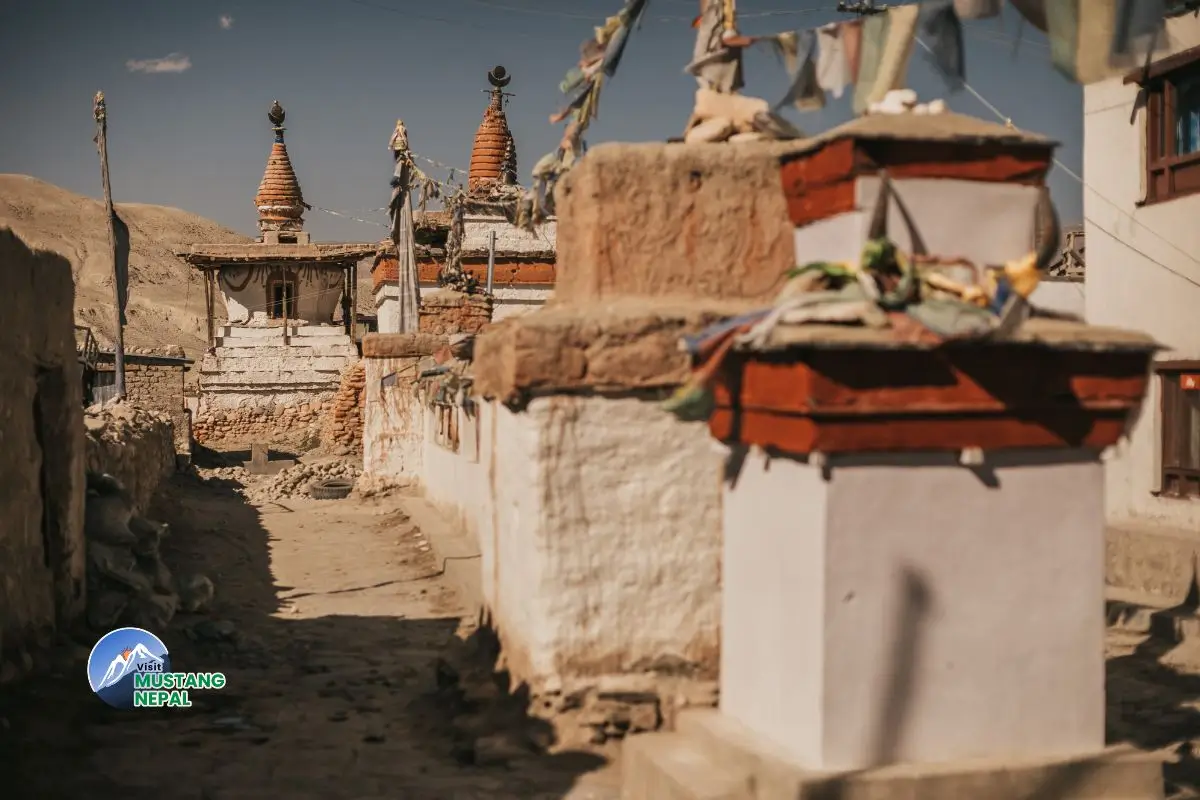
Modern Mustang
Modern Mustang is an isolated mountain region in northern Nepal that combines ancient Tibetan Buddhist culture with modern life. Although the people have maintained their traditions, language, and style of living, the region is gradually taking in new things, particularly
through controlled tourism that brings money but also threatens their culture. New roads connecting Lo Manthang to Tibet have made the area less isolated, but this could lead to too much business development.
You can see the mix of old and new everywhere. Donkeys still carry goods while people also use motorbikes, and solar panels now power homes that used to only use butter lamps for light. Young people try to balance using smartphones with joining traditional festivals like Tiji. Climate problems like the land turning into a desert are making people work harder to protect Mustang’s fragile environment and historic places.
Final Thoughts
The history of Mustang is a part that must be read, not just looked at. The soul of the Kingdom of Lo, exemplified by kings like Ame Pal, breathes life into Nepal of today, and the chants of Buddhist monks and the streets of Lo Manthang record the history of a people of strength. Travelling to Mustang can be compared to accessing a desert in Nepal that crosses the past and present under the Himalayas. It serves as a reminder of Nepal’s rich heritage and its unique legacy.
Ready to explore Mustang? Whether you want a cultural tour, a trekking adventure, or to witness the Tiji Festival, our travel experts will design a tailor-made Mustang experience just for you. Book your Mustang adventure today and walk through a living kingdom frozen in time.
FAQ’s
What are the Sky Caves?
The Sky Caves are the Mustang Caves. There are approximately 10,000 artificial caves located in the Mustang District of Nepal. These caves served various purposes, including habitation, meditation, and burial.
When was the Lo Manthang palace built?
The Lo Manthang Palace was built in 1441 by Ame Pal, the first king of the region. This palace not only served as a royal residence but also played a significant role in the governance and cultural life of the Kingdom of Lo.
What is the historical significance of Mustang in Nepal?
The historical significance of Mustang is the trade between Tibet and Nepal. It practiced the exchange of goods, ideas, and cultural practices. Its unique Tibetan-influenced heritage has been preserved over centuries, making it a significant area for understanding the cultural dynamics of the region.
Who founded the Kingdom of Lo and when?
Ame Pal founded the kingdom of Lo. He established Lo Manthang as the capital of Mustang. Later, it became the political and cultural heart of the kingdom.
When was Lo Manthang established as the capital?
Lo Manthang was established as the capital in 1380 AD, marking the beginning of its prominence in the region.
Which monarchs were prominent in Mustang’s history?
Prominent rulers in Mustang’s history include Ame Pal, the founder of the Kingdom of Lo, and Jigme Dorje Palbar Bista, the last king of Mustang. Jigme’s reign marked the end of the monarchy in the area and the transition to modern governance.
What religions influenced Mustang historically?
Tibetan Buddhism influenced Mustang historically, being near to Tibet. It influenced the spiritual practices, art, and architecture of the monks of Tibet.
Which are the most important monasteries and temples in Mustang?
Thubchen Lhakang Monastery, Narsingh Monastery, and Muktinath Temple are the important monasteries and temples in Mustang.
How has Mustang preserved its cultural and historical heritage?
Mustang has preserved its cultural and historical heritage through vibrant festivals like Tiji, ancient monasteries and strong community traditions. They play a crucial role in maintaining unique identity and cultural practices.
Why is Lo Manthang considered the historical center of Mustang?
Lo Manthang is considered the historical center of Mustang because it served as the capital of the Kingdom of Lo in the past. It was the political and cultural hub of the region.
What is the legacy of Mustang in modern Nepal?
The history of Mustang demonstrates the great blend of various cultures in Nepal, its traditional values, and modern power. This area is visited by researchers, tourists, and individuals interested in culture, helping show that Nepal values its history while also accepting new modern ways.
